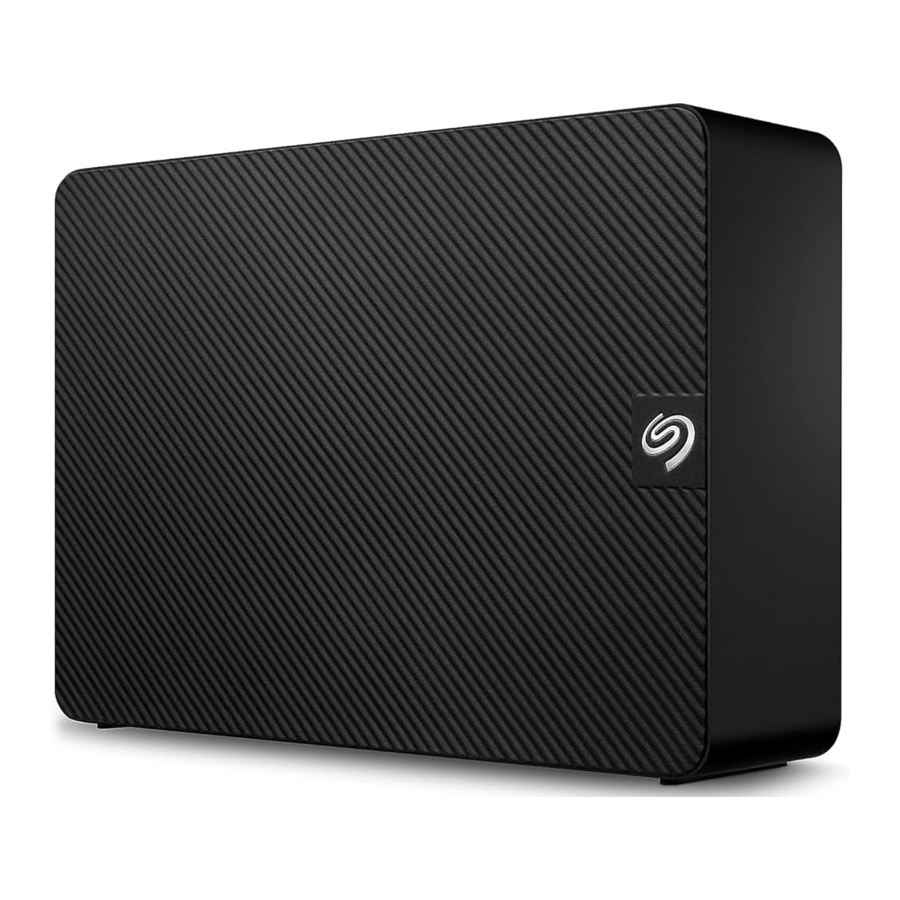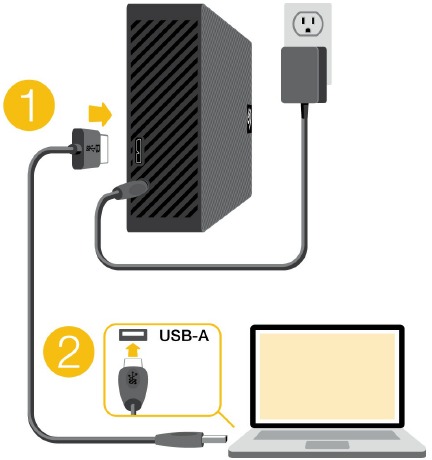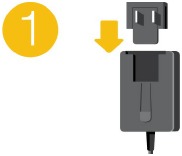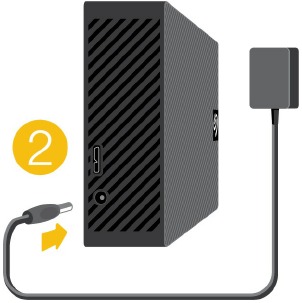
Seagate Expansion Desktop SRD0NF2 Manual
- User manual (15 pages) ,
- Datasheet (2 pages) ,
- Specifications (2 pages)
Advertisement

Box content
- Seagate Expansion Desktop
- 18W power adapter
- USB 3.0 cable (USB micro-B to USB-A)
- Quick start guide
Minimum system requirements
Ports
Use the included cable to connect your Seagate device to a computer with a USB-A port.
This device supports connections to computer ports that are USB 3.0 and higher.
Operating system
Go to Operating System Requirements for Seagate Hardware & Software.
Getting Started
Connect power
- Place the adapter plug for your location into the channel on the power supply. Slide it down to lock it in place.
![]()
- Connect the power cable to Expansion Desktop.
![Seagate - Expansion Desktop - Connect power - Step 1 Connect power - Step 1]()
- Connect the power supply to a live power outlet.
![Seagate - Expansion Desktop - Connect power - Step 2 Connect power - Step 2]()
Connect to computer

- Connect the USB micro-B end of the cable to the USB micro-B port on Expansion Desktop.
- Connect the USB-A end of the cable to your computer's USB-A port.

Optional Formatting and Partitioning
Your device is preformatted exFAT (Extended File Allocation Table) for compatibility with both Mac and Windows computers.
Choosing a file system format
When choosing a file system format, consider whether compatibility or performance is more important in your everyday use of the drive.
- Compatibility — You need a cross-platform format because you connect your drive to both PCs and Macs.
- Performance — You connect your drive with only one type of computer, so you can optimize file copy performance by formatting the drive in the native file system for your computer operating system.
Compatibility with both Windows and Macs
exFAT is a lightweight file system compatible with all versions of Windows and modern versions of macOS. If you use your drive with both PCs and Macs, format your drive in exFAT. While exFAT offers crossplatform access to both computers, keep in mind the following:
- exFAT is not compatible or recommended for built-in backup utilities such as File History (Windows) and Time Machine (macOS). If you want to use one of these backup utilities, you should format the drive in the native file system for the computer running the utility.
- exFAT is not a journaled file system, which means it can be more susceptible to data corruption when errors occur or the drive is not disconnected properly from the computer.
Optimized performance for Windows
NTFS (New Technology File System) is a proprietary journaling file system for Windows. macOS can read NTFS volumes, but it can't natively write to them. This means your Mac can copy files from an NTFS-formatted drive, but it can't add files to or remove files from the drive. If you need more versatility than this one-way transfer with Macs, consider exFAT.
Optimized performance for macOS
Apple offers two proprietary file systems.
Mac OS Extended (also known as Heirarchical File System Plus or HFS+) is an Apple file system used since 1998 for mechanical and hybrid internal drives. macOS Sierra (version 10.12) and earlier use HFS+ by default.
APFS (Apple File System) is an Apple file system optimized for solid state drives (SSDs) and flash-based storage systems, though it also works with hard disk drives (HDDs). It was first introduced with the release of macOS High Sierra (version 10.13). APFS can only be read by Macs running High Sierra or later.
When choosing between Apple file systems, consider the following:
- Windows cannot natively read or write to APFS or HFS+ volumes. If you need cross-platform compatibility, you should format the drive in exFAT.
- If you intend to use your drive with Time Machine:
- The default format for macOS Big Sur (version 11) and later is APFS.
- The default format for macOS Catalina (version 10.15) and earlier is HFS+.
- If you intend to use your drive to move files between Macs running older OS versions, consider formatting your drive in HFS+ rather than APFS.
- macOS file systems and Android: Formatting your drive for macOS may not be supported with connections to Android mobile devices.
Learn more
For additional considerations when choosing a file system format, see File System Format Comparisions.
Formatting instructions
For instructions on formatting your drive, see How to format your drive.
Safely Remove Device From Your Computer
Always eject a storage drive from your computer before physically disconnecting it. Your computer must perform filing and housekeeping operations on the drive before it is removed. Therefore, if you unplug the drive without using the operating system's software, your files can become corrupt or damaged.
Windows
Use the Safely Remove tool to eject a device.
- Click the Safely Remove Hardware icon in your Windows System Tray to view the devices you can eject.
- If you don't see the Safely Remove Hardware icon, click the Show hidden icons arrow in the system tray to display all icons in the notification area.
- In the list of devices, choose the device you want to eject. Windows displays a notification when it is safe to remove the device.
- Disconnect the device from the computer.
Mac
There are several ways you can eject your device from a Mac. See below for two options.
Eject via Finder window
- Open a Finder window.
- On the sidebar, go to Devices and locate the drive you want to eject. Click the eject symbol to the right of the drive name.
- Once the device disappears from the sidebar or, the Finder window closes, you can disconnect the interface cable from your Mac.
Eject via Desktop
- Select the desktop icon for your device and drag it to the Trash.
- When the device icon is no longer visible on your desktop, you can physically disconnect the device from your Mac.
Frequently Asked Questions
For help setting up and using your Seagate hard drive, review the frequently asked questions below. For additional support resources, go to Seagate customer support.
All users
Problem: My file transfers are too slow
Q: Are both ends of the USB cable firmly attached?
A: Review troubleshooting tips for cable connections below:
- Check both ends of the USB cable and make sure that they are fully seated in their respective ports.
- Safely eject the drive from your computer, disconnect the cable, wait 10 seconds, and then reconnect the cable.
- Try a different USB cable.
Q: Is the hard drive connected to a Hi-Speed USB 2.0 port on your computer or hub?
A: If your hard drive is connected to a Hi-Speed 2.0 port or hub, the inferior performance is normal. Seagate Expansion Desktop performance will improve when it is connected to a SuperSpeed USB 3.0 port.
Otherwise, the device operates at slower USB transfer rates.
Q: Are there other USB devices connected to the same port or hub?
A: Disconnect other USB devices and see if the hard drive's performance improves.
Problem: My computer only has USB-C ports
Q: My computer has smaller, USB-C ports. How do I connect the drive to my computer?
A: A USB-C cable is not included with this drive. You have two options:
- Use a cable with a USB micro-B end and a USB-C end. This cable must support USB 3.0 and higher.
- Use an adapter with a female USB Type A port and a male USB-C end.
Problem: I must use a USB hub for my USB devices
Q: Can I use my hard drive with a USB hub?
A: Yes, the hard drive can be connected to a USB hub. If you use a hub and encounter detection problems, slower than normal transfer rates, random disconnection from your computer or other unusual issues, try connecting the hard drive directly to the computer's USB port.
Some USB hubs are less than efficient with power management, which can be problematic for connected devices. In such a case, consider trying a powered USB hub that includes a power cable.
Please note that USB 2.0 hubs limit your hard drive's transfer rates to USB 2.0 speeds.
Problem: The provided USB cables are too short
Q: Can I use my hard drive with a longer cable?
A: Yes, provided it is a cable that meets USB standards. However, Seagate recommends using the cable shipped with your hard drive for the best results. If you use a longer cable and experience problems with detection, transfer rates or disconnection, use the original cable included with your hard drive.
Problem: I'm receiving file transfer error messages
Q: Did you get an "Error -50" message while copying to a FAT32 volume?
A: When copying files or folders from a computer to a FAT32 volume, certain characters in the names cannot be copied. These characters include, but are not limited to: ? < > / \:
Check your files and folders to ensure that these characters are not in the names.
If this is a recurring problem or you cannot find files with incompatible characters, consider reformatting the drive to NTFS (Windows users) or HFS+ (Mac users). See Optional Formatting and Partitioning.
Q: Did you get an error message telling you that the drive has been disconnected when coming out of sleep mode?
A: Ignore this message since the drive remounts on the desktop despite the pop-up. Seagate drives conserve power by spinning down when you set your computer to sleep mode. When the computer awakes from sleep mode, the drive may not have enough time to spin up, causing the pop-up to appear.
Windows
Problem: The hard drive icon doesn't appear in Computer
Q: Is the hard drive listed in Device Manager?
A: All drives appear in at least one place in Device Manager.
Type  in Search to launch it. Look in the Disk Drives section and, if necessary, click the Plus (+) icon to view the full list of devices. If you're uncertain that your drive is listed, safely unplug it and then reconnect it. The entry that changes is your Seagate hard drive.
in Search to launch it. Look in the Disk Drives section and, if necessary, click the Plus (+) icon to view the full list of devices. If you're uncertain that your drive is listed, safely unplug it and then reconnect it. The entry that changes is your Seagate hard drive.
Q: Is your hard drive listed next to an unusual icon?
A: Windows Device Manager usually provides information about failures with peripherals. While the Device Manager can assist with troubleshooting most problems, it may not display the exact cause or provide a precise solution.
An unusual icon next to the hard drive can reveal a problem. For example, instead of the normal icon based on the type of device, it has an exclamation point, question mark or an X. Right click this icon and then choose Properties. The General tab provides a potential reason why the device is not working as expected.
Mac
Problem: The hard drive icon does not appear on my desktop
Q: Is your Finder configured to hide hard drives on the desktop?
A: Go to Finder and then check Preferences | General tab | Show these items on the desktop. Confirm that Hard Disks is selected.
Q: Is your hard drive mounting in the operating system?
A: Open Disk Utility at Go | Utilities | Disk Utility. If the hard drive is listed in the left-hand column, check your Finder preferences to see why it is not displayed on the desktop (review the question above). If it is grayed out, it is not mounted. Click on the Mount button in Disk Utility.
Q: Does your computer's configuration meet the minimum system requirements for use with this hard drive?
A: Refer to the product packaging for the list of supported operating systems.
Q: Did you follow the correct installation steps for your operating system?
A: Review the installation steps in Getting Started.
https://tehnoteka.rs
Documents / ResourcesDownload manual
Here you can download full pdf version of manual, it may contain additional safety instructions, warranty information, FCC rules, etc.
Advertisement






















Need help?
Do you have a question about the Expansion Desktop and is the answer not in the manual?
Questions and answers